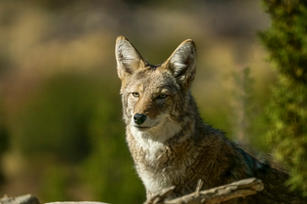Coyotes




At first I didn’t know what it was. No more than several inches at its broadest, it was a strange path stretching from the bottom of the arroyo directly up the side and then onward below the crest, uninterrupted by large rocks and dried juniper limbs, seemingly with contempt for the contours of the land. Perhaps it was a course used by the most hearty mountain bikers but that made little sense as I looked at the obstacles dotting it. Then I saw two coyotes moving along it perhaps two hundred feet below me. They were in coyote rhythm, loping, perhaps what we called diddy-bopping on the South Side, a syncopated stutter-step glide impervious to changing terrain and obstacles. The narrow coyote path itself suggested one of the secrets of their unique gait: no more than four inches in width at any point, more narrow than their bodies.
Coyotes move like water, rarely altering their flow for blockages in their way. I determined to study the phenomenon more. What I am beginning to see is a frequent coyote habit of trotting -- loping -- with feet landing under the center of their bodies. I remain unsure of this; perhaps it is one of many distinct coyote gaits, analogous to horses' canters, gallops, etc. I wonder if center-body foot placement explains coyotes' ease of movement, seamless directional changes and ability to maintain constant speed in rough terrain.
It takes time to let go of the misunderstanding, disinformation, and sheer ignorance regarding coyotes that we carry inside. Most people greatly overestimate the size and weight of the creatures and assume they are one hundred to one hundred twenty-five pounds; a large adult is usually in the thirty-five pound range. They tend to be svelte under their fur, nearly “all leg”, as tall as sled dogs or taller. Most people believe they are pack animals like wolves, highly social and communal killers of large prey and livestock. Coyotes will hunt in groups if large prey is plentiful but spend most of their lives in mated pairs with periods raising pups. Semi-permanent coyote packs have been observed in protected environments like Yellowstone, but Zoologists are not sure this behavior is a specific and recent response to the reintroduction of wolves there.
Wolves kill coyotes. Yet, when I arrived in New Mexico nearly two decades ago I was told that some astonishing percentage of American wolves had coyote DNA in their bodies and nearly no coyotes had any wolf DNA in theirs. Wiley coyotes indeed. Since then, a new breed is spreading from the eastern parts of the U.S. and Canada, the “coywolf” which some consider a new species. According to Geneticists, these canids stem from the pairing of coyotes and the red wolf, whose ancestors remained in North American while those of the grey wolf migrated to Asia over land bridges eons ago and evolved genetically before returning. The coyote, like the red wolf, stayed in North America and became smaller, turning into omnivores in the process and subsisting most of the time on rodents not sought by the apex predators, functionally removing themselves as competitors for large prey in the carnivore world. It is thought that the coyote brain became larger in the process as well.
A comment must be made about our preconceptions of coyotes and the Warner Brothers’ Cartoons. Chuck Jones, the animator/creator of Wile E. Coyote and The Road Runner, a personal hero of mine — and a sage commentator on The Human Condition: “Bugs Bunny is who we think we are, Daffy Duck is who we really are” — spent a lot of time in New Mexico and observed many coyotes. He got a lot of coyote characteristics right (remember, Wile E. is a genius and can also be a buffoon). But although coyotes are not known to seek road runners, they can sprint at forty miles per hour and the fastest any road runner has been clocked on the ground is twenty-seven mph. If a duel really did exist between coyotes and road runners, perhaps it would be the bird who turns to the Acme Corporation for help. For additional perspective on coyote life, see the section The Coyote Way and Coyote v. Acme, by Ian Frazier published in The New Yorker.















